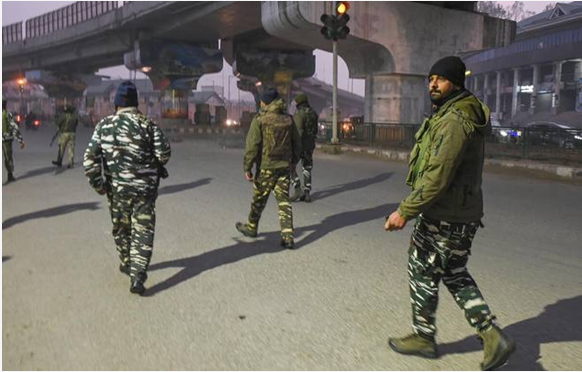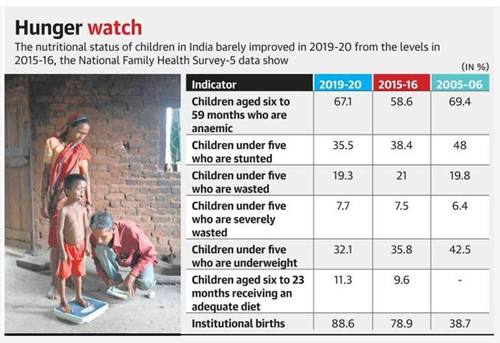
The News Editorial Analysis 25th November 2021
SC notice to Centre, IITs on petition seeking implementation of reservation policy.
The Supreme Court on Wednesday issued notices to the Centre and IITs on a petition seeking directions to them to follow reservation policy in admission in research degree programmes as also recruitment of faculty members.
A Bench led by Justice LN Rao asked the Centre and IITs to respond to the petition filed by SN Pandey after his counsel Ashwani Kumar Dubey submitted that the IITs were not following the reservation policy.
“The respondents (IITs) are completely violating the reservation policies that provide for reservation to socially and marginalised communities belonging to the SC (15%), ST 17%) and OBCs (27%)’, the petitioner submitted.
The petitioner also urged the top court to issue necessary directives for creation of a mechanism for resolving the students/scholars and research harassment complaints and to set up a panel of technical experts to review the performance of existing faculty members.
Pandey demanded cancellation of the appointment of certain appointments due to violation of reservation norms and framing of a transparent recruitment policy.
“It is submitted that the process of taking admissions in the research programme and appointment of faculty members by the respondents (IITs) are completely unconstitutional, illegal and arbitrary. The respondents are not following the guidelines of reservation as per the constitutional mandate,” Pandey submitted in his petition.
The IITs were not following the transparent process of recruiting the faculty members which opens up the window for non-deserving and candidates to enter IITs through connections that increases the chances of corruption, favouritism and discrimination, affecting internal ranking and technological growth of the country, he alleged.
Ohmium ships its first hydrogen electrolyser unit to the US.
With an aim to establish India as a global hub for green hydrogen generation, Ohmium International, through its Indian subsidiary, has shipped its first unit of electrolyser from India to the US. Ohmium manufactures the electrolyser at its Bengaluru plant.
Green hydrogen is a key component of the country’s goal to achieve net-zero emissions. This push towards decarbonisation will lead to several investments in innovation across energy efficiency, renewable energy and emission-free green hydrogen.
BENGALURU: With an aim to establish India as a global hub for green hydrogen generation, Ohmium International, through its Indian subsidiary, has shipped its first unit of electrolyser from India to the US. Ohmium manufactures the electrolyser at its Bengaluru plant.
Green hydrogen is a key component of the country’s goal to achieve net-zero emissions. This push towards decarbonisation will lead to several investments in innovation across energy efficiency, renewable energy and emission-free green hydrogen.
Centre’s free foodgrain scheme on till March

Acknowledging that poor families still need food security support in the middle of a recovering economy, the Centre has decided to extend its free ration scheme, Pradhan Mantri Garib Kalyan Anna Yojana (PMGKAY), for another four months, until March 2022.
At its meeting on Wednesday, the Union Cabinet also gave its formal approval to repeal three contentious farm reform laws in the winter session of Parliament, as announced by Prime Minister Narendra Modi last week.
“On [November] 19th, PM announced, and today, within five days, we have fulfilled all the formalities. In the upcoming winter session, the priority would be to take these Bills and repeal them at the earliest,” Information and Broadcasting Minister Anurag Thakur told presspersons in a briefing on Cabinet decisions.
However, he evaded questions on the farmers’ continued demand for a legal guarantee on minimum support prices for their crops, and declined to set any timeline on the PM’s promise to set up a committee to make the MSP more effective and transparent, as well as to change crop patterns and promote zero-budget agriculture.
In its other major decision, the Cabinet approved the extension of the PMGKAY which provides more than 80 crore ration card holders with five kg each of rice or wheat a month free of cost, in addition to the five kg which they are eligible for on a subsidised basis under the National Food Security Act. Initially introduced in the first COVID-19 relief package from April 2020, the scheme has been extended thrice, but was scheduled to end in November. Earlier this month, Food Secretary Sudhanshu Pandey had told presspersons that there was no proposal for extension as the economy was reviving.
“In the last more than 20 months, we have seen that the poor, even the middle class families have suffered, not here but globally as well. One of the ways to help the poor families was to give them foodgrains,” Mr. Thakur said.
“We still feel as the economy is getting back on track, the figures are looking much better. At the same time, Prime Minister wants to help those poor families who have gone through this COVID-19 pandemic, so that for the next four months, they should be helped and foodgrains should be given to them,” the Minister added.
In the run-up to the Uttar Pradesh Assembly election, the State Government had announced a unilateral extension of the PMGKAY until March 2022.
Several other State Governments and political parties demanded an extension by the Centre, although Food Ministry officials said no direct request had been received, and Mr. Pandey insisted that the decision had not been taken with UP alone in mind.
This fifth phase of the scheme, from December 2021 to March 2022 will entail an estimated subsidy of ₹53,345 crore, with a total outgo of 163 lakh tonnes of grain, according to an official statement.
The first four phases have already seen almost 600 lakh tonnes of grain allocated to States, at a subsidy cost of about ₹2.07 lakh crore.
Mr. Pandey told presspersons that despite the higher outgo due to PMGKAY, the Food Corporation of India’s food grain reserves currently stand at a record 616 lakh tonnes and are expected to increase to 942 lakh tonnes by June 2022 following rabi season procurement, stretching FCI’s storage capacities to their maximum limits.
Right to Food activists have argued that given the high reserves, the Centre should extend PMGKAY till May and universalise subsidised food grain distribution as well.
More hospital births, but limited gains in childhood nutrition:National Family Health Survey-5
Total Fertility Rate has dropped to 2.0, indicating just replacement level.
Births in institutional facilities, such as a hospital, improved by nearly eight percentage points but children who were either stunted or displayed signs of wasting only dropped by a maximum of three percentage points, shows a comparison of National Family Health Survey-5 (NFHS-5) and NFHS-4.
The complete results of the NFHS-5 were made public on Wednesday. The NFHS-4 was released in 2014-15 and the latest, which captured population health indicators in 2017-19, was delayed due to the pandemic.
Growth under check
India has also officially hit a total fertility rate (TFR) of 2.0 that indicates a decrease from the 2.2 in the NFHS-4. According to the United Nations Population Division, a TFR of about 2.1 children per woman is called replacement-level fertility. If replacement level fertility is sustained over a sufficiently long period, each generation will exactly replace itself. The urban TFR is 1.6 and the rural TFR is 2.1
“This is a significant feat for the country’s family-planning programme, which does not include coercive policies. These findings bust the population-explosion myth and show that India must steer away from coercive measures of population control. While the increase in the use of modern contraceptive methods is heartening, an increase in female sterilisation coupled with continued stagnation in male sterilisation uptake shows that the onus of family planning still lies with women,” the Population Foundation of India, a nongovernmental organisation, said in a statement.
An overall survey of the major differences between the NFHS-5 and NFHS-4 suggests that the use of contraceptives has improved from 53.5% to 66.7% in the latest NFHS-5 and institutional births increased from 78.9% to 88.6%.
The proportion of children (12-23 months) who were fully vaccinated improved from 62%-76% and children under 6 months who were exclusively breastfed also showed a sharp improvement from 54.9 to 63.7%.
he complete results of the NFHS-5 were made public on Wednesday. The NFHS-4 was released in 2014-15 and the latest, which captured population health indicators in 2017-19, was delayed due to the pandemic.

Pointers that India is witnessing a K-shaped recovery
The economic ravages of the pandemic have had an uneven impact and taxation policies continue to be regressive
There has been great chatter about a V-shaped recovery for quite a while, ever since the first lockdown following the novel coronavirus pandemic. A V-shaped recovery is characterised by quick and effective recovery in measures of economic performance after an acute decline in the economy. There is undeniably some type of recovery, but one can hardly label it V-shaped. The economic ravages of the pandemic have had an uneven impact on different socio-economic groups. The recovery we see today is more K-shaped than V-shaped, with various groups and industries recovering much more rapidly than their counterparts.
Signs from industry
Government taxation policies continue to be regressive, with increased indirect taxes and lower direct taxes placing greater tax incidence on the destitute. The effects of this K-shaped recovery can be observed through the growth and consumption in specific industries.
Two-wheelers represent the economic situation of the lower and middle-class groups and India’s small businesses. A report by analytical company CRISIL indicates that in the year 2021, two-wheeler sales are set to decline by 3%-6% year-over-year. This is on top of a lower base in the year 2020 already affected by the pandemic. The actual decline of two-wheeler sales from pre-pandemic times on account of the base effect must be much more significant. The sales of two-wheelers are the second-lowest it has been in seven years. It is imperative to note that entry-level models are the ones most affected under the category of two-wheelers. The festival season was said to rectify this phenomenon, but it had been unable to. On the other hand, premium cars and premium motorcycles have been resistant to the pandemic slowdown.
Impact of taxation
Moreover, the usurious taxation policy of the Government, which insists on maintaining indirect taxes on fuel and consumer products while lowering corporate taxes, paints a picture explaining these figures. The Government had recently raised taxes on textile products from 5% to 12%. While inflation soars, the incomes of the middle and lower-middle-class have at best remained constant. There is tremendous pressure on the financial stability of these households, which seemingly face a sustained loss in disposable income. Besides, the figures representing those who are employed only partially explain this phenomenon.
On jobs, NREGA
Over five million or 50 lakh people lost their jobs in October, according to a Centre for Monitoring Indian Economy (CMIE) report. Many of those who lost their jobs during this period are likely economically insecure and abstain from non-essential purchases. This, paired with the astronomically high food and fuel prices, delivers a deadly blow pushing families to poverty.
Stimulus and growth
Therefore, there seems to be no surprise that the consumption of two-wheelers and other such products has taken a significant hit. The U.S. and European economies have stimulated the economy bottom-up through unemployment cheques and social welfare schemes. The economist, John Maynard Keynes, popularised the concept of the money multiplier and the relationship between government stimulus and economic growth. It fundamentally makes great sense to prioritise those who are more likely to spend (the middle and lower-middle-class) rather than those who have a greater propensity to save. The velocity of money which sustained a significant shock from pandemic lockdowns needs to be kickstarted. Furthermore, the inflation of asset prices over the recovery period helps determine the nature of this recovery.












